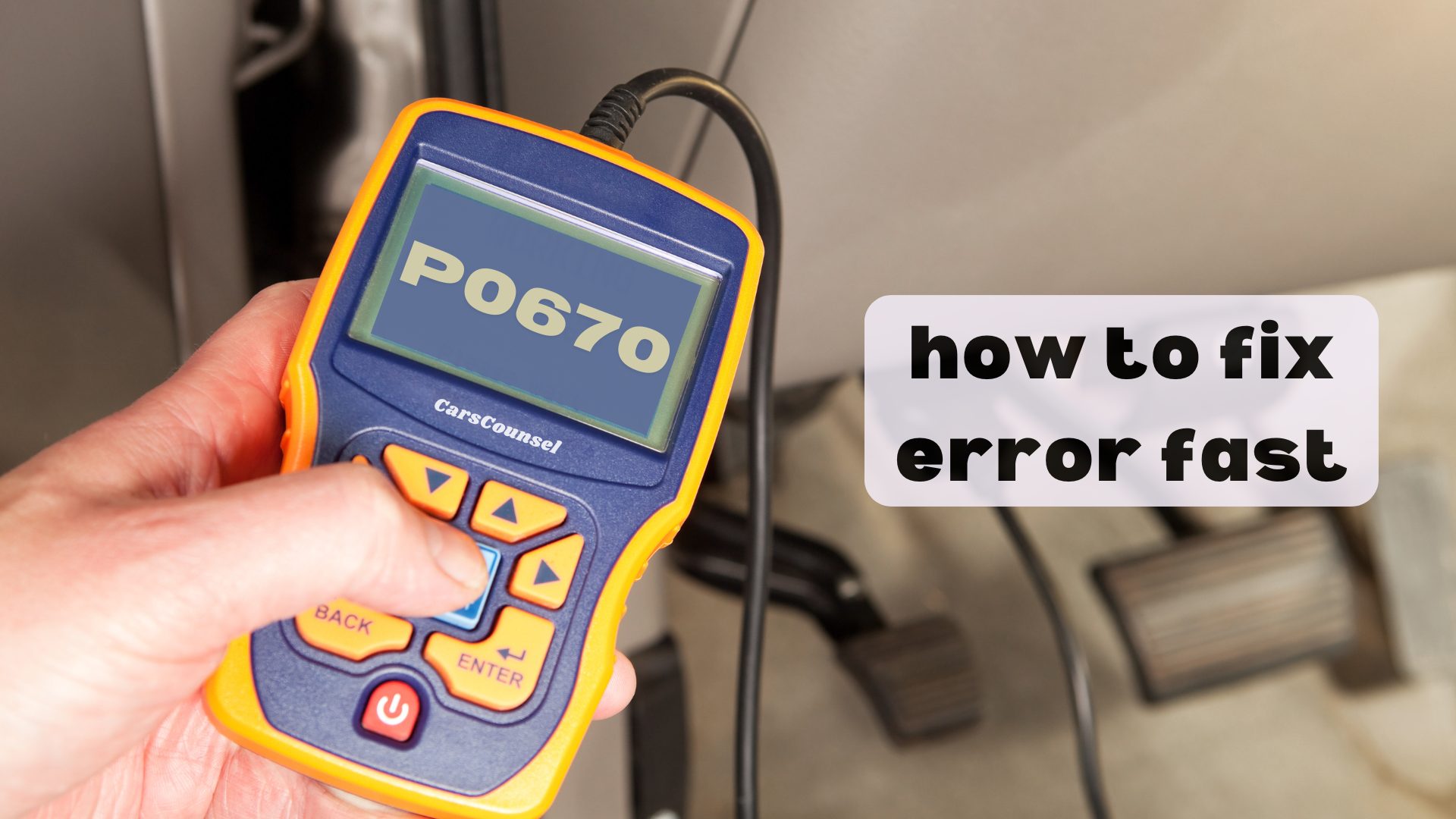Ever wondered if you can quickly fix the P0670 code?
This error code means there’s a problem with your vehicle’s glow plug control module, which can mess up your engine’s performance if you ignore it.
First, check the glow plugs and wiring for any damage or rust.
But don’t stop there. You need a step-by-step approach to fix this problem fast and efficiently.
Let’s go through the steps to get your engine running smoothly again.

Quick Navigation
Key Takeaways
- Look over the glow plugs and change any that are damaged or worn out to help the engine start properly.
- Check and fix any wiring problems, including shorts or loose connections, to make sure the control module works correctly.
- Test the glow plug relay and replace it if it doesn’t pass voltage or contact tests.
- Use an OBD-II scanner to confirm and clear the P0670 code, keeping an eye out for any recurring issues.
What Is the P0670 Code?
The P0670 code means there’s a problem with the Glow Plug Control Module Circuit, which is crucial for starting diesel engines, especially in cold weather.
When this code comes up, it indicates an issue with your glow plug system. This system heats the combustion chambers, making it easier for your diesel engine to start.
If the glow plugs aren’t working right, your engine might have trouble starting, especially in cold temperatures. The problem could be due to bad glow plugs, a faulty control module, or wiring issues.
Fixing the P0670 code quickly can prevent more engine problems and ensure your diesel engine starts reliably no matter the weather.
Symptoms of P0670
If your diesel engine is hard to start, especially in cold weather, it may be due to a P0670 code. You might see more exhaust smoke when starting, experience engine misfires, or feel rough idling. These problems can be linked to issues with your glow plugs. Additionally, you could notice lower fuel efficiency and the check engine light might come on. Catching these problems early can help prevent serious damage.
| Symptom | Description | Impact |
|---|---|---|
| Difficulty Starting | Hard to start engine in cold weather | Affects reliability |
| Increased Exhaust Smoke | More smoke when starting | Indicates inefficiency |
| Engine Misfires | Irregular engine firing | Reduces performance |
| Rough Idling | Uneven engine operation | Causes discomfort |
| Reduced Fuel Efficiency | Higher fuel consumption | Increases costs |
Spotting these symptoms early can help you fix the P0670 code sooner.
Common Causes of P0670
Faulty glow plugs or connections often cause the P0670 code, leading to various engine problems. Knowing the common causes can help you troubleshoot effectively.
Here’s a quick overview:
- Glow Plug Care: Glow plugs can wear out or get damaged over time. Regular checks and maintenance ensure they work properly.
- Wiring Issues: Problems like shorts or breaks in the wiring can mess up the glow plug control module. Look for damaged or corroded wires.
- Broken Parts: A bad glow plug relay or module, or issues with the engine control module (ECM), can also set off this code.
Impact on Engine Performance
A P0670 code can really mess with how your engine runs, especially when it’s cold outside. You’ll notice your car takes longer to start, there’s more smoke coming from the exhaust, and it doesn’t idle smoothly. These problems make your engine less efficient and can cause bigger issues if you don’t fix them. Cold weather makes things worse, so it’s important to deal with this code as soon as you can. Here’s what happens to your engine:
| Problem | How It Affects the Engine | Other Problems It Causes |
|---|---|---|
| Slow Starting | Hard to start in cold | Drains the battery |
| Rough Idling | Bad combustion | Uses more fuel |
| More Exhaust Smoke | Bad fuel burning | Pollutes the air |
| Engine Misfires | Unstable running | Can damage the engine |
| Lower Efficiency | Costs more in fuel | Shortens engine life |
Fixing the issue quickly keeps your engine running smoothly and reliably.
Initial Visual Inspection
Start your initial visual check by looking at the glow plug system for any signs of damage or rust. Here are some simple steps to help you spot any problems quickly:
- Look at Glow Plug Connections: Closely inspect the terminals and connectors for any rust, loose connections, or broken wires.
- Check Glow Plug Placement: Make sure each glow plug is securely in place and doesn’t show any visible damage.
- Inspect the Wiring: Trace the wiring from the glow plug control module to each glow plug, looking for any wear and tear, fraying, or exposed wires.
Using an OBD-II Scanner
After checking the glow plug system, the next step is to use an OBD-II scanner to confirm if the P0670 code is present and to get more diagnostic information.
Make sure your scanner works with OBD II and is compatible with your vehicle. Plug the scanner into the OBD-II port, usually found under the dashboard. Turn on the ignition and follow the scanner’s instructions to read the codes.
Check if P0670 is there and take note of any other codes. The scanner can show real-time data, which helps you find the problem’s source.
After noting the codes, clear them to see if P0670 comes back, which means the problem is ongoing. This step is crucial for accurate troubleshooting and effective repair.
Checking Glow Plug Resistance
How to Check Glow Plug Resistance
To check the resistance of your glow plugs, you’ll need a multimeter. Here’s how you can do it:
- Disconnect the Glow Plug: Make sure the engine is off and cool. Unplug the electrical connector from the glow plug to separate it.
- Measure Resistance: Set your multimeter to the ohms setting. Place one probe on the glow plug terminal and the other on a ground point. Write down the resistance value you see.
- Compare Values: Look up the correct resistance range in your vehicle’s manual. If the value you measured is way off, the glow plug is probably bad and needs to be replaced.
Testing Glow Plug Relay
When testing the glow plug relay, make sure you check for the right voltage and that the connections are working properly.
Start by finding the relay, usually near the engine. Use a multimeter to check the voltage at the relay’s terminals to see if it matches what the manufacturer says it should be.
Then, test the relay contacts to make sure they aren’t damaged or corroded. Testing the relay correctly is crucial for keeping the glow plugs working well, as a bad relay can cause starting problems and make the P0670 code appear.
If the relay doesn’t pass the tests, replace it right away to keep the engine running smoothly and avoid more problems.
Accurate measurements and quick action are important to fix glow plug relay issues.
Fixing Wiring Issues
Fixing damaged or corroded wiring in the glow plug circuit is key to solving the P0670 code. Here’s how you can do it:
- Check connections: Make sure all the connectors are tight and not rusty.
- Test with a multimeter: Use a multimeter to see if the current is flowing properly through the wires.
- Repair or replace wires: Fix any wires that are damaged or put in new ones if needed.
Cost of Repairs
After fixing wiring problems, it’s important to know what it might cost to repair the P0670 code. The cost depends on the issue.
For example, replacing a bad glow plug control module usually costs about $300. If the glow plugs are the problem, it can cost between $100 and $300.
Fixing damaged wires or connections can be more expensive, depending on labor costs and how easy it is to get the parts. If the ECM (Engine Control Module) is broken, it will cost a lot more to replace or reprogram it.
Regular maintenance and quick repairs can help you avoid bigger issues and save money over time. Always ask a trusted mechanic for a detailed estimate to avoid any surprise costs.
More OBD-II Codes
Frequently Asked Questions
Can Driving With a P0670 Code Cause Long-Term Engine Damage?
Driving with a P0670 code can hurt your engine performance over time. Use diagnostic tools to find the problem quickly. Ignoring it can cause more exhaust smoke, rough idling, and possible long-term engine damage.
How Often Should Glow Plugs Be Inspected or Replaced?
Glow plugs are like the heart of your diesel engine. Check them every 20,000 miles to keep your engine running well. Their lifespan can differ, so follow the manufacturer’s advice on when to replace them to prevent expensive repairs.
What Tools Are Needed to Test a Glow Plug Circuit?
You’ll need a multimeter to check the resistance of the glow plugs, an OBD-II scanner to read any fault codes, and some basic tools like pliers and screwdrivers to look over the circuit. Testing the circuit properly ensures you can diagnose and fix any issues correctly.
Are There Any Preventive Measures to Avoid a P0670 Code?
Think of a well-maintained engine compared to a rusty one. To avoid a P0670 code, regularly maintain your glow plugs, check connections, and follow diesel engine tips like timely inspections and keeping the battery in good shape. These preventive steps keep engines running smoothly.
Can Weather Conditions Affect the Likelihood of a P0670 Code Appearing?
Yes, weather can increase the chances of a P0670 code showing up. Cold weather puts extra stress on the glow plug system, making problems more obvious. Make sure to keep up with regular maintenance to reduce these weather-related issues.
Conclusion
To wrap things up, fixing the P0670 code might seem like a wild goose chase, but with a careful look and the right tools, you’ll have it sorted in no time.
Start with a visual check, then inspect and replace any faulty glow plugs and relays.
Don’t forget to check the wiring—fixing any issues there can make all the difference.
A little effort now can save you bigger headaches later, ensuring your engine runs smoothly.

